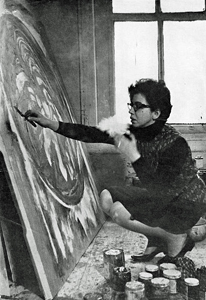Sonia Gechtoff facts for kids
Quick facts for kids
Sonia Gechtoff
|
|
|---|---|
 |
|
| Born |
Sonia Alice Gechtoff
September 25, 1926 |
| Died | February 1, 2018 (aged 91) New York, New York, U.S.
|
| Education | San Francisco Art Institute |
| Alma mater | Pennsylvania Academy of the Fine Arts |
| Known for | Painting |
| Movement | Abstract Expressionism |
| Spouse(s) | James Kelly (1953-2003; his death) |
| Children | Susannah Leigh Kelly Miles Tamarind Kelly |
Sonia Gechtoff (born September 25, 1926 – died February 1, 2018) was an American artist. She was famous for her exciting abstract paintings. Abstract art uses shapes, colors, and lines instead of showing things that look real. Sonia mostly painted, but she also made drawings and prints.
Contents
Early Life and Art Education
Sonia Gechtoff was born in Philadelphia. Her mother, Ethel, managed art galleries, including her own gallery in San Francisco. Sonia's father, Leonid Gechtoff, was a very talented artist from Ukraine. He painted scenes from everyday life.
Sonia's father helped her start painting when she was just six years old. He would have her sit next to him with her own brush and paints. Everyone could see Sonia's talent early on. She went to special schools and classes for children who were gifted in art. In 1950, she earned her degree from the Pennsylvania Academy of the Fine Arts.
Becoming a Famous Artist
In 1951, Sonia moved to San Francisco. There, she became friends with many other artists. She was part of the lively art scene known as the Beat Generation. Sonia felt that women abstract artists in San Francisco had more opportunities than those in New York.
She quickly started working in the style of Abstract Expressionism. This art movement uses strong colors and brushstrokes to show feelings. Some of her best-known works were created in San Francisco. One famous painting is called Etya, which is now in the Oakland Museum of California.
In 1953, Sonia married James "Jim" Kelly, who was also a well-known artist.
Sonia's art became famous across the country in 1954. Her work was shown at the Guggenheim Museum in a special exhibition. Her paintings were displayed alongside those of very famous artists like Willem de Kooning and Jackson Pollock.
After her mother passed away in 1958, Sonia and Jim moved to New York. They quickly became part of the New York art world. Sonia's work was shown in major galleries and always received great reviews. She also taught art at several universities, including New York University.
Sonia's Unique Art Style
When Sonia was a teenager, she was inspired by Ben Shahn. He was an artist who focused on social realism. This style of art showed the struggles of working-class people.
Later, Sonia was influenced by the artist Clyfford Still. She learned important ideas about lines and shapes from his work. People sometimes call her a "second-generation Abstract Expressionist."
Sonia's own special style appeared in the early 1950s. She created bright, bold paintings on very large canvases. Many of her works, like The Angel (1953–55), were like abstract self-portraits. She used bright colors and thick, energetic brushstrokes. These strokes suggested a main figure with arms reaching across the painting.
In 1956, she started her unique "hair" drawings. These were masses of lines that tangled into wispy shapes floating on the paper. Her bold, swirling art was so impressive that it was shown at the Brussels World's Fair in 1958.
Later in her career, after moving to New York, Sonia found new inspiration. She drew ideas from the Brooklyn Bridge, old buildings, and the sea. You can see these forms in her later paintings, which sometimes looked like collages. Sonia kept developing her art throughout her life. She never stuck to just one style. Her work always remained abstract. She also started using graphite in her paintings after switching from oil to acrylic paints. This gave her art a sense of rhythm with lines.
Sonia also enjoyed creating series of works on a single theme. She made sets of multiple canvases that formed one complete artwork. One of her final sets was a six-canvas series called "Skip's Garden."
An art collector named Charles Dean said that Sonia Gechtoff was "the most prominent woman working in California in the '50s." This shows how important her art was.
Notable Art Exhibitions
Sonia Gechtoff's work was shown in many important art exhibitions.
Group Exhibitions
- USA Pavilion, Brussels World Fair: "17 American Painters", 1958
- Museum of Modern Art, New York, 1977
- Guggenheim Museum, New York, "Younger American Painters 1954-55"
- "Women of Abstract Expressionism" at the Palm Springs Art Museum, California, 2017
Solo Exhibitions
- Six Gallery, San Francisco, 1955
- De Young Museum, San Francisco, 1957
- Ferus Gallery, Los Angeles, 1957, 1959
- Poindexter Gallery, New York, 1959, 1960
Awards and Recognition
Sonia Gechtoff received several awards for her artistic achievements:
- 1963 – Ford Foundation Fellowship
- 1988, 1994, 1998 – Pollock-Krasner Foundation Grant
- 1989 – National Endowment for the Arts Grant
- 1993 – Elected into the National Academy of Design
- 2013 – Lee Krasner Lifetime Achievement Award
Where to See Her Art
Sonia Gechtoff's paintings are part of many important art collections. You can find her work in:
- Metropolitan Museum of Art, New York
- San Francisco Museum of Modern Art, California
- Museum of Modern Art, New York
- Whitney Museum, New York
- Menil Collection, Houston, Texas

